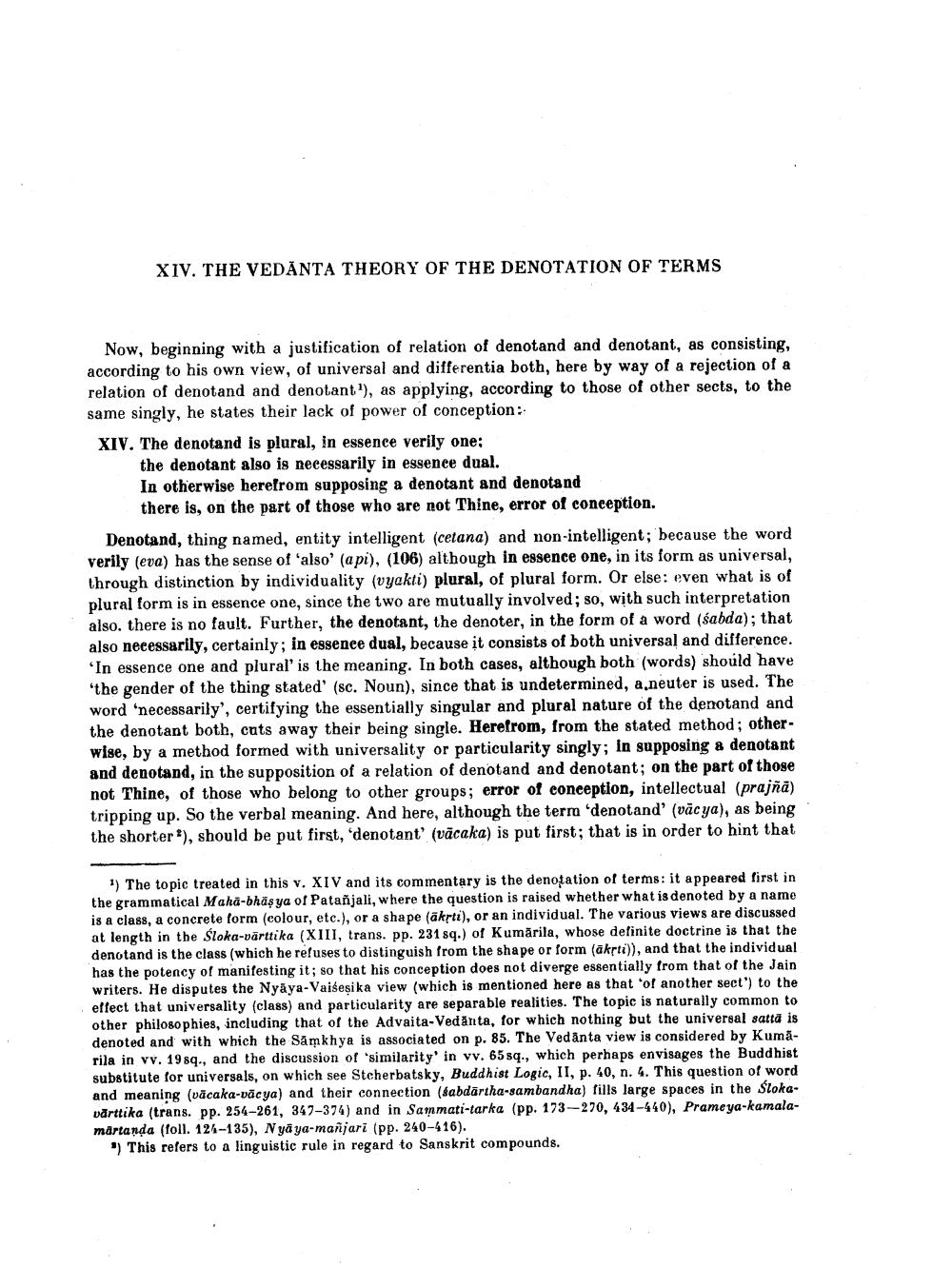________________
XIV. THE VEDANTA THEORY OF THE DENOTATION OF TERMS
Now, beginning with a justification of relation of denotand and denotant, as consisting, according to his own view, of universal and differentia both, here by way of a rejection of a relation of denotand and denotant), as applying, according to those of other sects, to the same singly, he states their lack of power of conception :: XIV. The denotand is plural, in essence verily one;
the denotant also is necessarily in essence dual. In otherwise herefrom supposing a denotant and denotand there is, on the part of those who are not Thine, error of conception.
Denotand, thing named, entity intelligent (cetana) and non-intelligent; because the word verily (eva) has the sense of 'also' (a pi), (106) although in essence one, in its form as universal, through distinction by individuality (vyakti) plural, of plural form. Or else: even what is of plural form is in essence one, since the two are mutually involved; so, with such interpretation also, there is no fault. Further, the denotant, the denoter, in the form of a word (sabda); that also necessarily, certainly; in essence dual, because it consists of both universal and difference. "In essence one and plural' is the meaning. In both cases, although both (words) should have 'the gender of the thing stated' (sc. Noun), since that is undetermined, a.neuter is used. The word 'necessarily', certifying the essentially singular and plural nature of the denotand and the denotant both, cats away their being single. Herefrom, from the stated method; otherwise, by a method formed with universality or particularity singly; in supposing a denotant and denotand, in the supposition of a relation of denotand and denotant; on the part of those not Thine, of those who belong to other groups; error of conception, intellectual (prajña) tripping up. So the verbal meaning. And here, although the term 'denotand' (vācya), as being the shorter *), should be put first, denotant' (vācaka) is put first; that is in order to hint that
1) The topic treated in this v. XIV and its commentary is the denotation of terms: it appeared first in the grammatical Maha-bhäş ya of Patañjali, where the question is raised whether what is denoted by a name is a class, a concrete form (colour, etc.), or a shape (äkrti), or an individual. The various views are discussed at length in the Sloka-vārttika (XIII, trans. pp. 231 sq.) of Kumārila, whose definite doctrine is that the denotand is the class (which he refuses to distinguish from the shape or form (akrti)), and that the individual has the potency of manifesting it; so that his conception does not diverge essentially from that of the Jain writers. He disputes the Nyāya-Vaiseșika view (which is mentioned here as that of another sect') to the effect that universality (class) and particularity are separable realities. The topic is naturally common to other philosophies, including that of the Advaita-Vedānta, for which nothing but the universal satta is denoted and with which the Samkhya is associated on p. 85. The Vedanta view is considered by Kumarila in vv. 19sq., and the discussion of 'similarity' in vv. 65 sq., which perhaps envisages the Buddhist substitute for universals, on which see Steherbatsky, Buddhist Logic, II, p. 40, n. 4. This question of word and meaning (vācaka-vācya) and their connection (labdārtha-sambandha) fills large spaces in the Slokavårttika (trans. pp. 254-261, 347-374) and in Sammati-tarka (pp. 173-270, 434-440), Prameya-kamalamartanda (foll. 124-135), Nyāya-manjari (pp. 240-416).
This refers to a linguistic rule in regard to Sanskrit compounds.




